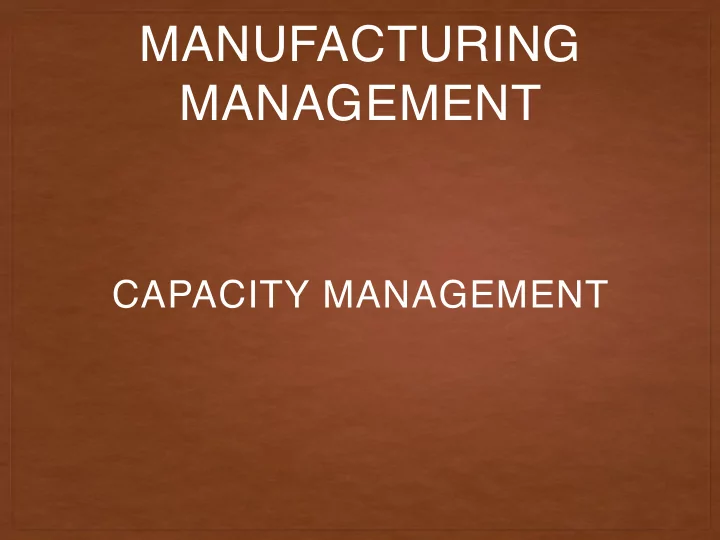

MANUFACTURING MANAGEMENT CAPACITY MANAGEMENT
What is Capacity management
The management of the limits of an organization's resources, such as its labor force, manufacturing and office space, technology and equipment, raw materials, and inventory.
Capacity constraints
Capacity Long term Medium term planning Short term
THE OBJECTIVES OF CAPACITY PLANNING AND CONTROL • Cost • Revenues • Working capital • Quality • Speed • Dependability • Flexibility
CLASSIFICATION OF CAPACITY PLANNING • Long term capacity planning • Short term capacity planning • Finite capacity planning • Infinite capacity planning
THE STEPS IN CAPACITY PLANNING AND CONTROL Source: Operations Management / Nigel Slack, Stuart Chambers, Robert Johnston. – 6Th Ed. Prentice Hall
FORECASTING IS A KEY INPUT TO CAPACITY PLANNING AND CONTROL
REQUIREMENTS FROM A DEMAND FORECAST FOR CAPACITY CONTROL • It is expressed in terms which are useful for capacity planning and control • It is as accurate as possible • It gives an indication of relative uncertainty
SEASONALITY OF DEMAND Source: “Operations Management” Nigel Slack, Stuart Chambers, Robert Johnston
MEASURING CAPACITY
EFFECTIVE CAPACITY CAN BE INFLUENCED BY: • technical abilities in the pre-operations stages • organizational skills in the planning stages • purchasing skills • sub-contracting skills • maintenance policies • versatility of work force • efficiency of work force
UTILIZATION AND EFFICIENCY OF THE PLANT
example Suppose the photographic paper manufacturer has a coating line with a design capacity of 200 square metres per minute, and the line is operated on a 24-hour day, 7 days per week (168 hours per week) basis. Design capacity is 200 × 60 × 24 × 7 = 2.016 million square metres per week. The records for a week’s production show the following lost production time: LOSS PRODUCTION TIME FOR A WEEK 1 Production changeovers 20 hours Regular preventative 2 16 hours 20+16+8+8+7 maintenance 3 No work scheduled 8 hours Unavoidable =59 hours 4 Quality sampling checks 8 hours 5 Shift change items 7 hours 6 Maintenance breakdown 18 hours 7 Quality failure investigation 20 hours 18+20+8+6+6 8 Coating material stockout 8 hours Unplanned =58 hours 9 Labour shortages 6 hours 10 Waiting for paper rolls 6 hours during this week the actual output was only 582, 000 square meters.
example solution Design capacity = 168 hours per week Effective capacity = 168 - 59 = 109 hours Actual output = 168 - 59 - 58 = 51 hours actual output 51 hours Utilization = ———————— = ————— = 0,304 (30%) design capacity 168 hours actual output 51 hours Efficiency = ———————— = —————— = 0,468 (47%) effective capacity 109 hours
OVERALL EQUIPMENT EFFECTIVENESS • Time • Quality • Speed
OVERALL EQUIPMENT EFFECTIVENESS OEE = a × p × q Source: Operations Management / Nigel Slack, Stuart Chambers, Robert Johnston. – 6Th Ed. Prentice Hall
ALTERNATIVE CAPACITY PLANS • level capacity plan • chase demand plan • demand management
LEVEL CAPACITY PLAN • Level capacity plans which use anticipation inventory to supply future demand
CHASE DEMAND PLAN • Chase demand capacity plans with changes in capacity which reflect changes in demand Source: Operations Management / Nigel Slack, Stuart Chambers, Robert Johnston. – 6Th Ed. Prentice Hall
ADJUSTING CAPACITY METHODS • Overtime and idle time • Varying the size of the workforce • Using part-time staff • Subcontracting
DEMAND MANAGEMENT • Change demand • Alternative products
MIXED PLANS Source: Operations Management / Nigel Slack, Stuart Chambers, Robert Johnston. – 6Th Ed. Prentice Hall • A mixed capacity plan for the woollen knitwear factory
YIELD MANAGEMENT • Capacity is relatively fixed • The market can be fairly clearly segmented • The service cannot be stored in any way • The services are sold in advance • The marginal cost of making a sale is relatively low
THE END
Recommend
More recommend